
Unas or Wenis, also spelled Unis, was a pharaoh, the ninth and last ruler of the Fifth Dynasty of Egypt during the Old Kingdom. Unas reigned for 15 to 30 years in the mid-24th century BC, succeeding Djedkare Isesi, who might have been his father.

Saqqara, also spelled Sakkara or Saccara in English, is a vast, ancient burial ground in Egypt, serving as the necropolis for the ancient Egyptian capital, Memphis. Saqqara contains numerous pyramids, including the world-famous Step pyramid of Djoser, sometimes referred to as the Step Tomb, and a number of mastaba tombs. Located some 30 km (19 mi) south of modern-day Cairo, Saqqara covers an area of around 7 by 1.5 km.

Teti, less commonly known as Othoes, sometimes also Tata, Atat, or Athath in outdated sources, was the first king of the Sixth Dynasty of Egypt. He is buried at Saqqara. The exact length of his reign has been destroyed on the Turin King List but is believed to have been about 12 years.

Pepi II was a pharaoh of the Sixth Dynasty in Egypt's Old Kingdom who reigned from c. 2278 BC. His throne name, Neferkare (Nefer-ka-Re), means "Beautiful is the Ka of Re". He succeeded to the throne at age six, after the death of Merenre I.
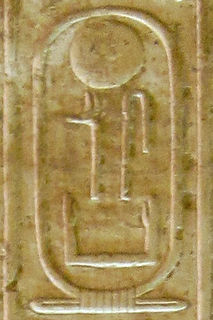
Userkare was the second pharaoh of the Sixth Dynasty, reigning briefly, 1 to 5 years, in the late 24th to early 23rd century BC. Userkare's relation to his predecessor Teti and successor Pepi I is unknown and his reign remains enigmatic. Although he is attested in historical sources, Userkare is completely absent from the tomb of the Egyptian officials who lived during his reign. In addition, the Egyptian priest Manetho reports that Userkare's predecessor Teti was murdered. Userkare is often considered to have been a short-lived usurper. Alternatively, he may have been a regent who ruled during Teti's son's childhood who later ascended the throne as Pepi I.
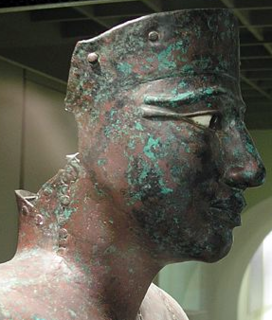
Pepi I Meryre was an Ancient Egyptian pharaoh, third king of the Sixth Dynasty of Egypt, who ruled for over 40 years at the turn of the 24th and 23rd centuries BC, toward the end of the Old Kingdom period. He was the son of Teti, the founder of the dynasty and ascended the throne only after the brief intervening reign of the shadowy Userkare. His mother was Iput, who may have been a daughter of Unas, the final ruler of the preceding Fifth Dynasty. Pepi I, who had at least six consorts, was succeeded by his son Merenre Nemtyemsaf I, with whom he may have shared power in a coregency at the very end of his reign. Pepi II Neferkare, who might also have been Pepi I's son, succeeded Merenre.

The Sixth Dynasty of ancient Egypt along with the Third, Fourth and Fifth Dynasty constitute the Old Kingdom of Dynastic Egypt.

Djedkare Isesi was a pharaoh, the eighth and penultimate ruler of the Fifth Dynasty of Egypt in the late 25th century to mid-24th century BC, during the Old Kingdom. Djedkare succeeded Menkauhor Kaiu and was in turn succeeded by Unas. His relations to both of these pharaohs remain uncertain, although it is often conjectured that Unas was Djedkare's son, owing to the smooth transition between the two.
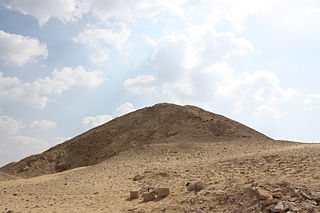
The Pyramid of Teti is a smooth-sided pyramid situated in the pyramid field at Saqqara in Egypt. It is the second known pyramid containing pyramid texts. Excavations have revealed a satellite pyramid, two pyramids of queens accompanied by cult structures, and a funerary temple. The pyramid was opened by Gaston Maspero in 1882 and the complex explored during several campaigns ranging from 1907 to 1965. It was originally called Teti's Places Are Enduring. The preservation above ground is very poor, and it now resembles a small hill. Below ground the chambers and corridors are very well preserved.

Prince Ankhhaf was an Egyptian prince and served as vizier and overseer of works to the Pharaoh Khufu, who was Ankhhaf's half-brother. He lived during Egypt's 4th Dynasty.
Sesheshet, occasionally known as Sesh, was the mother of King Teti, the first and founding pharaoh of the Sixth Dynasty of Ancient Egypt. She was instrumental in enabling her son to gain the throne and reconciling two warring factions of the royal family.
Khufukhaf I was an ancient Egyptian prince and vizier of the 4th Dynasty.
Khuit II was a wife of King Teti, the first pharaoh of the Sixth Dynasty of Egypt.
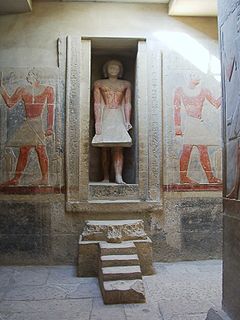
Mereruka served during the Sixth Dynasty of Egypt as one of Egypt's most powerful officials at a time when the influence of local state noblemen was increasing in wealth and power. Mereruka held numerous titles along with that of Vizier, which made him the most powerful person in Egypt after the king himself. Some of the other state titles which Mereruka held included 'Inspector of the priests attached to the pyramid of Teti', 'Governor of the palace', 'Chief lector-priest', 'Overseer of the royal record scribes' and 'Director of all the works of the king'.
Neferseshemre also called Seshi was a vizier from the early or middle part of the reign of King Teti of the Sixth Dynasty of Egypt.
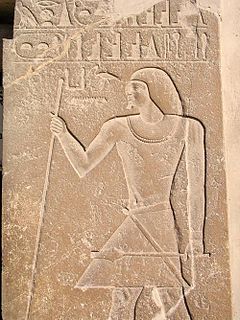
Kagemni was a vizier from the early part of the reign of King Teti of the Sixth Dynasty of Egypt. Kagemni's wife Nebtynubkhet Sesheshet was a King's Daughter and likely the daughter of Teti.
Sekhemkare was a vizier from the Fifth Dynasty of Egypt. He was a son of king Khafre and queen Hekenuhedjet. He served as vizier during the beginning of the next dynasty, during the reigns of Userkaf and Sahure. Sekhemkare is the only son of Khafre whose death can be fairly securely dated to a precise reign, here that of Sahure.
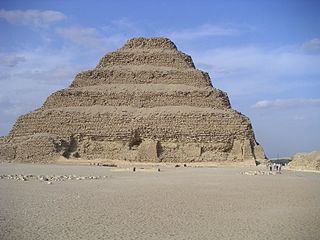
The Third Dynasty of ancient Egypt is the first dynasty of the Old Kingdom. Other dynasties of the Old Kingdom include the Fourth, Fifth and Sixth. The capital during the period of the Old Kingdom was at Memphis.
Mehu was an Ancient Egyptian vizier who lived in the Sixth Dynasty, around 2300 BC. The office of the vizier was the most important one at the royal court. Mehu is mainly known from his monumental mastaba at Saqqara, not far away from the Pyramid of Unas.
Rawer was an ancient Egyptian official of the Sixth Dynasty of Egypt. His main title was that of a vizier, making him to one of the highest officials at the royal court. Rawer is so far only known from his rather modest mastaba found at Saqqara, close to the pyramid of king Teti. Rawer had several titles, including overseer of Upper Egypt, but also royal sealer and beloved of god.











